Page 9374
Oct 24, 2018
The future of flying is electric planes
Posted by Genevieve Klien in categories: futurism, transportation
Oct 24, 2018
Ask a Spaceman: The Quirks of Quark Star Physics
Posted by Genevieve Klien in category: particle physics
Oct 24, 2018
NASA’s Parker Solar Probe snaps Earth pic as its speeds to the Sun
Posted by Genevieve Klien in category: space
NASA has released an image of the Earth captured by the Parker Solar Probe on its historic journey to the Sun.
The picture was captured on Sept. 25 by Parker’s Wide-field Imager for Solar Probe (WISPR) instrument.
When the image of the Earth was taken, Parker Solar Probe was about 27 million miles from Earth. The average distance between the Sun and Earth is 93 million miles.
Continue reading “NASA’s Parker Solar Probe snaps Earth pic as its speeds to the Sun” »
Oct 24, 2018
It Could be Possible to Transfer Data Through Gravitational Waves
Posted by Genevieve Klien in categories: physics, satellites

This discovery not only opened up an exciting new field of research, but has opened the door to many intriguing possibilities. One such possibility, according to a new study by a team of Russian scientists, is that gravitational waves could be used to transmit information. In much the same way as electromagnetic waves are used to communicate via antennas and satellites, the future of communications could be gravitationally-based.
The study, which recently appeared in the scientific journal Classical and Quantum Gravity, was led by Olga Babourova, a professor at the Moscow Pedagogical State University (MPSU), and included members from Moscow Automobile and Road Construction State Technical University (MADI) and the Peoples’ Friendship University of Russia (RUDN).
Continue reading “It Could be Possible to Transfer Data Through Gravitational Waves” »
Oct 24, 2018
FDA approves first new flu drug in nearly 20 years
Posted by Genevieve Klien in category: biotech/medical
Flu sufferers now have a new option for relieving symptoms. Xofluza (baloxavir marboxil), a single-dose, oral prescription drug, was approved by the US Food and Drug Administration on Wednesday. The antiviral is the first new flu treatment approved by the FDA in nearly 20 years, FDA Commissioner Dr. Scott Gottlieb said in a statement.
“With thousands of people getting the flu every year, and many people becoming seriously ill, having safe and effective treatment alternatives is critical,” said Gottlieb.
The pill is intended for patients who are 12 or older and who have had symptoms for no more than 48 hours. When patients with the flu, a respiratory illness, are treated within 48 hours of becoming sick, antiviral drugs can reduce symptoms and duration of illness, according to the FDA.
Oct 24, 2018
Birth canals are different all over the world, countering a long-held evolutionary theory
Posted by Genevieve Klien in category: futurism
Oct 24, 2018
Not exercising enough is worse for you than smoking and diabetes, study suggests
Posted by Genevieve Klien in categories: biotech/medical, life extension
A study suggests cardiorespiratory fitness is linked to a longer life, suggesting no exercise is worse for health than smoking or diabetes.
Oct 24, 2018
How Quantum Mechanics Lets Us See, Smell and Touch
Posted by Xavier Rosseel in category: quantum physics
Oct 24, 2018
Rock fluidization during peak-ring formation of large impact structures
Posted by Genevieve Klien in category: space
Large meteorite impact structures on the terrestrial bodies of the Solar System contain pronounced topographic rings, which emerged from uplifted target (crustal) rocks within minutes of impact. To flow rapidly over large distances, these target rocks must have weakened drastically, but they subsequently regained sufficient strength to build and sustain topographic rings. The mechanisms of rock deformation that accomplish such extreme change in mechanical behaviour during cratering are largely unknown and have been debated for decades. Recent drilling of the approximately 200-km-diameter Chicxulub impact structure in Mexico has produced a record of brittle and viscous deformation within its peak-ring rocks. Here we show how catastrophic rock weakening upon impact is followed by an increase in rock strength that culminated in the formation of the peak ring during cratering. The observations point to quasi-continuous rock flow and hence acoustic fluidization as the dominant physical process controlling initial cratering, followed by increasingly localized faulting.

















